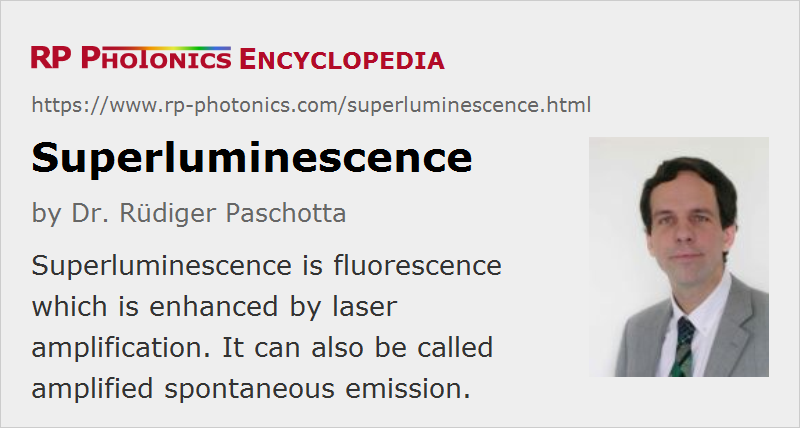Superluminescence
Definition: fluorescence which is enhanced by laser amplification
More general term: fluorescence
German: Superlumineszenz
Category: physical foundations
How to cite the article; suggest additional literature
Author: Dr. Rüdiger Paschotta
Superluminescence is the same as amplified spontaneous emission: the emission of luminescence which experiences significant optical gain within the emitting device, and therefore can be relatively intense. Due to the finite gain bandwidth, the bandwidth of the emitted light is usually smaller than that of the luminescence itself.
Superluminescence is often used for generating light with a broad bandwidth, e.g. in superluminescent diodes. Such light sources are called superluminescent sources or ASE sources.
Questions and Comments from Users
Here you can submit questions and comments. As far as they get accepted by the author, they will appear above this paragraph together with the author’s answer. The author will decide on acceptance based on certain criteria. Essentially, the issue must be of sufficiently broad interest.
Please do not enter personal data here; we would otherwise delete it soon. (See also our privacy declaration.) If you wish to receive personal feedback or consultancy from the author, please contact him e.g. via e-mail.
By submitting the information, you give your consent to the potential publication of your inputs on our website according to our rules. (If you later retract your consent, we will delete those inputs.) As your inputs are first reviewed by the author, they may be published with some delay.
See also: superluminescent sources, superluminescent diodes, amplified spontaneous emission, stimulated emission, luminescence, superfluorescence
and other articles in the category physical foundations
 |



If you like this page, please share the link with your friends and colleagues, e.g. via social media:
These sharing buttons are implemented in a privacy-friendly way!